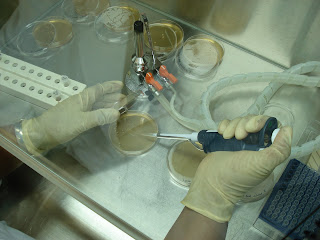3. TRANSFORMATION OF E.COLI WITH PLASMID DNA – Dr. Fukada
- Gene(s) of interest(s) can be isolated from organisms such as plants, bacteria or animals, and introduced to bacteria preferably E. coli for amplification. This is known as cloning. Thereafter, one can modify or analyze the gene and then insert it back to the organism. E. coli has the ability to take exogenous DNA naturally.
- Two methods are used to transform E. coli namely:
1. Chemical transformation
a) Hanahan method - which uses calcium ions. The transformation efficiency of this method is 5 x 107 – 1 x 108 / µg of DNA, hence is unstable.
b) The Cacl2 method – has a lower transformation efficiency of 5 x 106 to 2 x 107.
2. Physical transformation – mainly electroporation. This method uses high electric voltage to introduce the DNA into bacteria. The transformation efficiency of this method is 1 x 108 to 1 x 1010
- Two plasmids A and B, with sizes 3.5 kbp and 11 kbp respectively were used to transform E. coli and the results were analyzed and compared. The reagents and media for use and the electrocompetent cells were prepared.
- It was noted that 3 factors affected the transformation efficiency. These are:
Optical Density (OD) of bacterial culture that is usually 0.4 to 0.6 for electroporation, and it takes about 2-3 hours to attain this OD.
Temperature – all processes must be done at low temperatures or in ice, it is necessary to keep the bacteria alive. All reagents and instruments must be cooled before use.
Purity of the reagents – this is important for chemical transformation methods. Both water and reagents to be used must be pure. The supernatant must be completely removed before addition of the next solution. After centrifugation, the tube must be inserted into ice in slanting position and the surplus supernatant removed completely.
· For both plasmids, 2 µl of each plasmid was separately added into 100 µl of E. coli culture LB medium, mixed well, and the whole amount transferred to electroporation cuvette. 500 µl of LB was subsequently added to give a total volume of 600 µl and pulsed. 100 µl of mixture was picked and added into 900 µl of LB to obtain a diluted culture, while the remainder (500 µl) was undiluted.
· For both suspensions, (diluted and undiluted), 100 µl was put on LB agar plates and the suspension spread across the plates by rolling sterile glass beads. The plates were incubated at 370 C overnight.
· The transformation efficiency of E. coli was expressed as the number of colonies per µg of DNA. Upon calculation, the results were displayed in the following table:
| DNA | UNDILUTED | DILUTED |
| Plasmid A (3.5 kbp) | 2.18 x 108 | 2.31 x 108 |
| Plasmid B (11 kbp) | 1.17 x 107 | 1.5 x 107 |
It was noted that the transformation efficiency was high in plasmid A. The ratio of transformation A:B was 18.6:1 (transformation efficiency of plasmid A was 18.6 times higher than that of plasmid B). This experiment demonstrated that small-sized plasmids have higher transformation efficiency as compared to larger-sized plasmids.


No comments:
Post a Comment